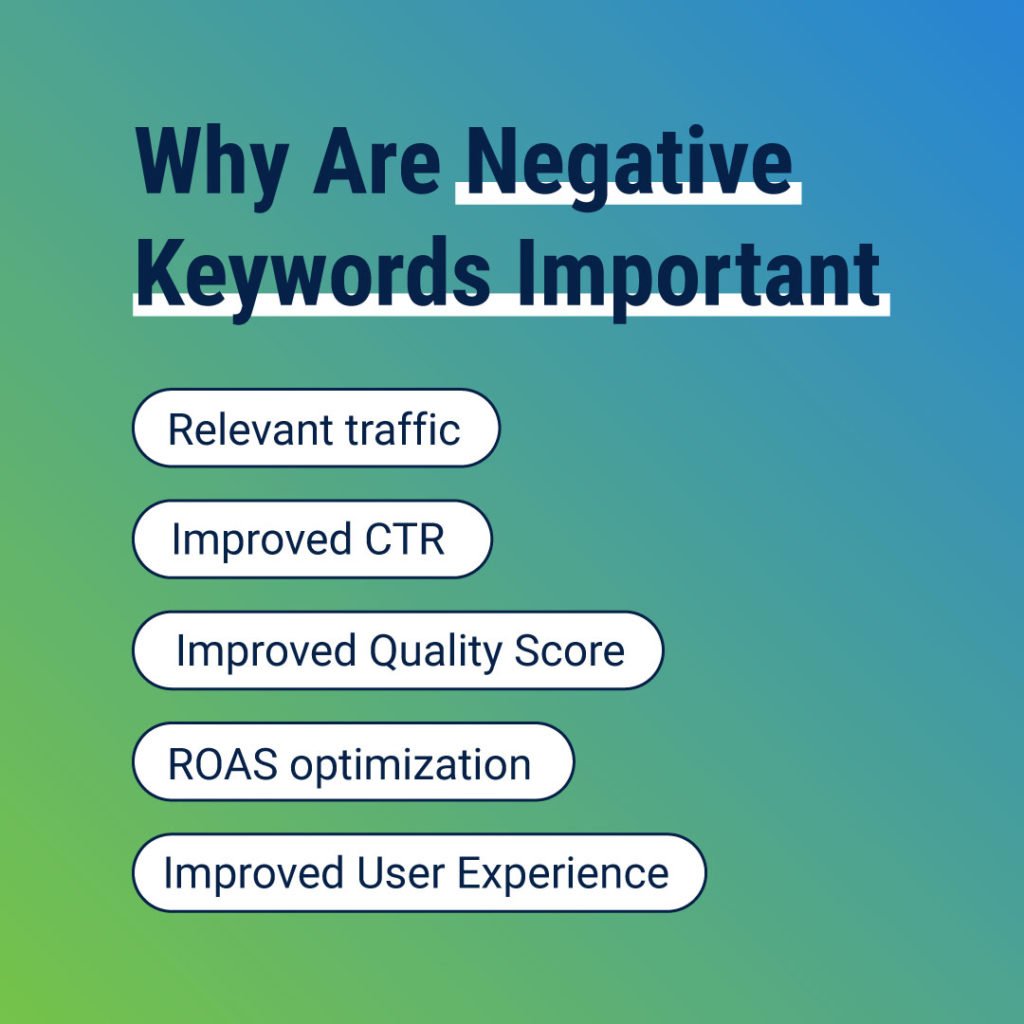Generating traffic and leads is the biggest challenge marketers and businesses face. Clearly, the matter is simple: In the absence of traffic, you can’t generate leads. And one of the quickest ways to send targeted traffic to your website is via Google Ads. Even more, if you want to send quality traffic to your website, you might want to learn how to build a negative keyword list.
Understanding what a negative keyword is and how to create a negative keyword list will help you improve targeting and save lots of advertising budget.
This guide covers everything you need to know about creating negative keyword lists to ensure your ads trigger the most relevant keywords.
What Are Negative Keywords?
A negative keyword is a term used in the PPC industry for keywords that won’t trigger your ads from showing. Normally, your ads show based on keywords. However, there are certain ambiguous keywords that send irrelevant traffic to your site.
Let’s look at an example.
You are selling a marketing automation tool and targeting the keyword: marketing automation tool. The report shows that your ad triggers for certain irrelevant keywords like marketing automation certification, marketing tool training, marketing automation lessons, etc.
These keywords will send irrelevant traffic to your website, as you don’t sell lessons, certifications, and training. You need to stop your ad to show for these keywords and this can be done by adding these keywords as negative keywords.
Here is another example:
Not all keywords are worth paying for. This is a reason why identifying negative keywords is crucial for the success of your Google Ads campaign.

Why Are Negative Keywords Important?
Negative keywords aren’t just optional, but downright mandatory for an effective Google Ads campaign. Here’s why::
1. They Help Bring Relevant Traffic
Irrelevant paid traffic is the last thing your business needs. Imagine you are selling candy and people visit your online store to buy cookies.
Negative keywords help you avoid this. They make paid traffic relevant. Your ads trigger for the right keywords. This improves the impressions, clicks, and click-through rate of your ads.
2. They Help Improve CTR
When your ads pop up for an irrelevant keyword, one of the following two things can happen:
- Your ad might receive an impression but it won’t be clicked since it is irrelevant to the searcher’s query
- Your ad might get clicked and you’ll receive a visitor. However, this type of visitor is least likely to convert and might bounce immediately.
In both cases, it impacts the click-through rate.
Adding negative keywords to your campaign will help you improve CTR significantly. Your target audience won’t just see your ads but they’ll actually click, visit your landing page, and convert. This is the whole point of running an ad campaign on Google Ads, right?
The ad CTR has other crucial implications too…
3. They Help Boost Quality Score
Google Ads assigns a quality score to keywords which is determined by different factors including the CTR you get on your ads. A high CTR means your ad is relevant to the keyword (and thus people are clicking it), this improves the quality score.
When you have a low CTR (because your ad is being triggered for irrelevant keywords), you’ll have a low-quality score. When your quality score declines, it lowers your ad rank and increases the cost per click. This is a clear enough reason to make sure you have created a negative keyword list.
Negative keywords improve CTR, quality score, and ad rank while lowering cost per click. Not bad.
4. They Help with ROAS Optimization
Negative keywords are important because they’re directly related to ROAS. Cost plays a significant role in ROAS and negative keywords reduce the cost of your campaigns.
If you do nothing else and just create a negative keyword list, you’ll be able to minimize cost by not spending on expensive irrelevant keywords.
Negative keywords also filter traffic and boost conversions. Your ad will only send relevant traffic to your landing page leading to a high conversion rate. This increases revenue.
Therefore, if you want to optimize ROAS, make sure you aren’t wasting money on negative keywords.
5. They Help Improve User Experience
It all comes down to UX.
Imagine people clicking your ad to buy something but when they visit your landing page, they don’t find it there. It ruins your brand image, credibility, and UX.
There is nothing more important than UX, as 88% of people say that they won’t return to a website after a bad user experience.
How to Build a Negative Keyword List
A negative keyword list is an inventory of all the negative keywords that you identify for your campaign. You can apply this list to all the campaigns you are running. Building a list and then applying it to relevant campaigns saves you from manual work.
For example, if you aren’t offering any courses or training for marketing automation. You can add such keywords in the negative list as you’ll want to exclude them from all the ad campaigns you’ll run.
So, a negative keyword list is an inventory of all the keywords that won’t trigger your ads. You can add/remove keywords from your list and they’ll be instantly applied to the relevant campaigns.
The problem is finding negative keywords for your campaign.
Here are the best ways to find negative keywords and move ahead towards building your negative keyword list:
Keyword Performance Report
It is also known as the search term report in Google Ads. This is the best place to find negative keywords that you don’t want to spend money on.
You can access search terms from your Google Ads account from the right sidebar. Click Keywords > Search terms:
Here is how the report looks like:
You can mark any keyword as negative from this list and add it to an existing negative keyword list.
Analyzing keyword performance report reveals a lot of critical information such as:
- Keyword impression
- Average cost
- Number of clicks
- Interaction rate
- Conversion rate.
These metrics help you identify negative keywords. Here is how to identify negative keywords from the report:
- Keywords that you don’t want to target
- Keywords with high average cost (CPC) but with minimal conversion rate
- High impression with low CTR
- Exceptionally high cost that you can’t afford.
Add all these keywords in an Excel sheet so you can add them to a negative keyword list.
Keyword Planner
Analyzing the search term report is the best way to find negative keywords as you can make data-driven decisions regarding the inclusion of negative keywords in your list. But there is a problem with this method.
The keyword performance report becomes available when you run an ad campaign. And if you access this report after running ads for a few good days, you might end up wasting a major portion of your daily budget on these negative keywords.
For example, a keyword with a CPC of $10 (as compared to the average CPC of $1.12) will exhaust your daily budget in no time.
This is a reason why you need to have a basic negative keyword list before you start running your ads. You can identify negative keywords from Google Keyword Planner. It is a handy tool that gives you a decent idea of related keywords that might trigger your ad.
You can access the Keyword Planner from your Google Ads account by clicking Tools and Settings > Keyword Planner:
You can get tons of keyword ideas based on a seed keyword. You’ll also see search volume and bid range for each keyword idea. It gets easier to identify negative keywords from this list:
These are the keywords that you need to add to your negative list to avoid showing your ad for these keywords.
Google Analytics and Search Console
Another super-easy way to build your negative keyword list before running your ad campaign is by analyzing Google Analytics and Search Console. These two Google products will provide you with tons of insights on the type of keywords that perform well and the keywords that have a high bounce rate.
For example, you can quickly scan Queries from Search Console to see keywords with clicks and impressions:
Look for irrelevant keywords that your website and pages are ranking for. These are the negative keywords that won’t bring in any value. Add all such keywords to your negative list.
Creating Your Negative Keyword List
Once you have identified the list of negative keywords, you are all set to create a list in Google Ads. As discussed above, when you create a negative keyword list, you can apply it to any campaign with a single click and you can add/remove keywords from the list. This saves you a lot of time.
Imagine you are running 20 ad campaigns for your business. It’ll become a challenging task to manually add negative keywords to all the campaigns and then keep track of the changes. You’ll spend your time dealing with negative keywords only if you don’t use lists.
Follow these steps to create a negative keyword list:
Step #1
Open your Google Ads account and click All Campaigns from the top menu:
Step #2
Click Keywords from the right sidebar and then click Negative keywords:
Step #3
Click the “+” button to create a new list. Select Add negative keywords or create a new list and then select the campaign or ad group of your choice:
Step #4
Paste all the keywords in the text box and check Save to a new or existing list. Give a name to your list and click Save:
Your negative keyword list is now created.
How to Use Your Negative Keyword List
Once you have created a negative keyword list, you can apply it to various campaigns with a single click. Then you need to keep your lists updated by adding more keywords by analyzing ad and keyword performance.
But first, let’s see how to apply a negative keyword list to different campaigns. You can access negative keywords from the top menu by clicking Tools and settings > Negative keyword lists:
You’ll see all the negative keyword lists you have created. Select a list and click Apply to campaigns:
Select relevant campaigns you want the list to apply to and then click Apply to save your settings:
Similarly, you can remove campaigns too when needed from your lists.
You can also add keywords to your lists from Search terms. This is the report that shows you all the search terms that triggered your ads. You can access these search terms under Keywords from the right sidebar:
Select any search term and add it to your negative keyword list.
Ideally, you need to monitor search terms regularly to identify and exclude irrelevant keywords. If you don’t do it, you might end up spending money on irrelevant keywords.
Conclusion
Negative keyword lists are necessary if you want to stay ahead of your competitors. These lists are extremely handy when you are running multiple ad campaigns for one or more businesses. A negative keyword list won’t just automate the process but it helps you save money.
There is no limit on how many negative keywords lists you can build. You can have as many as you want. However, what’s more important than creating negative keyword lists is to keep them updated. This is a continuous process where you need to find and add new search terms to your lists as they arise on a daily basis, so it’s important to keep in mind your list of negative keywords is never actually “done.”



